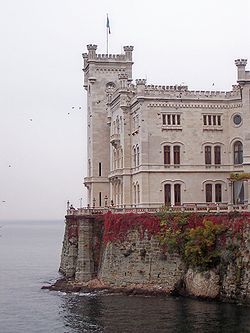Location
Where is the wedding?
Our wedding will take place in Trieste, Italy. That, as an interesting factoid, is Paolo's birthplace and where his family still lives to date.
About Trieste, Italy
Trieste (Italian: Trieste; Slovenian, Serbian, and Croatian: Trst; German: Triest) is a city and port in northeastern Italy right on the border with Slovenia. Trieste is located at the head of the Gulf of Trieste on the Adriatic Sea. With a population of 207,069 (2001) it is the capital of the autonomous region Friuli-Venezia Giulia and Trieste province.
Trieste flourished as part of Austria, from 1382 (the Austro-Hungarian Empire from 1867) until 1918 when it was among Central Europe's most prosperous Mediterranean seaports as well as a capital of literature and music. However, the collapse of the Austro-Hungarian Empire and Trieste's annexation to Italy after World War I led to a decline in its economic and cultural importance.
Today, Trieste is a border town. The population is an ethnic mix of the neighboring regions; The dominant local Venetian dialect of Trieste is called Triestine ("Triestin" – pronounced /triˈɛstin/, in Italian "Triestino"). This dialect and the official Italian language are spoken in the city center while Slovenian is spoken in several of the immediate suburbs. The Venetian and the Slovenian languages are considered autochthonous to the area. There are also a small number of German-speakers.
Places to visit in Trieste
 Castello di Miramare
Castello di Miramare
The Miramare Castle (Italian: Castello di Miramare; German: Schloss Miramar) is a 19th century castle, built for Austrian Archduke Maximilian and his wife, Charlotte of Belgium, later Emperor Maximilian I and Empress Carlota of Mexico. The castle is situated on the Gulf of Trieste near Trieste, northeastern Italy. Construction took place from 1856 to 1860 to a design by Carl Junker on the orders of Archduke Maximilian.
http://www.castello-miramare.it/
The castle's grounds include an extensive (22 hectares) cliff and seashore park Riserva Naturale Marina di Miramare designed by the Archduke. The grounds were completely re-landscaped to feature numerous tropical species of trees and plants.

Trieste Cathedral (San Giusto)
Trieste Cathedral, dedicated to San Giusto, is the Cathedral and main church of Trieste, in northern Italy.
Caves
In the whole Trieste province there are 10 speleological groups (24 in Friuli-Venezia Giulia). The Trieste plateau (Altopiano Triestino), called Kras or the Carso and covering an area of roughly 200 km² within Italy has approximately 1500 caves of various sizes (67 are more than 99 m deep). Among the most famous are the Grotta Gigante, the largest tourist cave in the world, with a single cavity large enough to contain St Peter's in Rome, and the Cave of Trebiciano (350 m deep) at the bottom of which flows the Timavo River. This river dives underground at Škocjan Caves in Slovenia (they are on UNESCO list) and flows about 30 km before emerging about 1 km from the sea in a series of springs near Duino reputed by the Romans to be an entrance to Hades.
Places just outside Trieste
 Venice
Venice
Venice (Italian: Venezia, Venetian: Venezsia, Latin: Venetia) is a city in northern Italy, the capital of region Veneto, and has a population of 271,251 (census estimate January 1, 2004). Together with Padua, the city is included in the Padua-Venice Metropolitan Area (population 1,600,000). Venice's nicknames include "Queen of the Adriatic", "City of Water", "City of Bridges", and "The City of Light".
The city stretches across 117 small islands in the marshy Venetian Lagoon along the Adriatic Sea in northeast Italy. The saltwater lagoon stretches along the shoreline between the mouths of the Po (south) and the Piave (north) Rivers. The population estimate of 272,000 inhabitants includes the population of the whole Comune of Venezia; around 62,000 in the historic city of Venice (Centro storico); 176,000 in Terraferma (literally firm land, the areas outside the lagoon), mostly in the large frazione of Mestre and Marghera; and 31,000 live on other islands in the lagoon.
 Lipica
Lipica
Lipica is a village in the municipality Sežana, in Slovenia, near the Italian border (Lipizza in Italian).Lipica is one of the main tourist centers of the Kras region. It is famous as the origin of the Lipizzaner horses. The stud farm Lipica was established in 1580 by Charles II, Archduke of Inner Austria (son of Ferdinand I, Holy Roman Emperor). Today the stud farm is fully functional and breeds the finest horses.
Postojna Cave (Slovenian: Postojnska jama; German: Höhlen von Postojna, Adelsberger Höhlen [older]; Italian: Grotte di Postumia) is a 20,570 m long Karst cave system near Postojna, Slovenia. It is the longest cave system in the country as well as one of its top tourism sites.
(note: yeah, a lot of stuff here is taken from wikipedia. Hey, it's mostly correct…)

